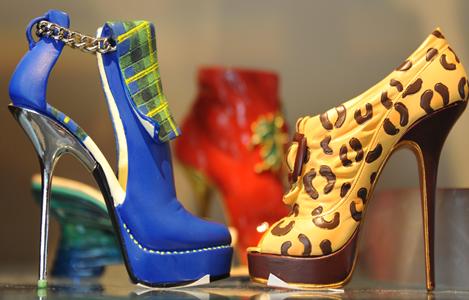|
Sole-stirring display
Photograph
by Preeti Verma Lal
And I thought I had a splendid shoe-sense. I was so haughty about my extravagant brown mukluk and hand-embroidered white silk shoes that I assumed I could step into any structure with stylish flamboyance. However, that breezy afternoon in Toronto ’s Bata Shoe Museum , my shoe arrogance was left sole-less. Literally. Blame it on a pair of 250-year old mojaris! No. This ain’t any lowly brogue. Fully embroidered with gold thread and encrusted with diamond, ruby, emerald and sapphire, this pair belonged to the former Nizam Sikander Jah of Hyderabad and is now the prized possession of the world’s largest shoe museum. I looked at its apricot coloured silk and velvet lining and silver braids on the wedge heels and flinched about the dust on my mukluk. My swish mukluk looked so bourgeois next to the exquisite mojaris which is currently valued at approximately – hold your breath – Rs 90 lakhs. Sigh!
That day in the shoe-box shaped Museum that houses nearly 13,000 shoes from six continents, I shed my footwear conceit at every shoe shelf of the India section. Under an impeccable glass pane lay a 19 th century silver filigreed mule with leaf and vine motifs. Made of pure silver, this perhaps was part of an Indian bride’s trousseau. An 1840 saffron pair of mojaris worn by a temple dancer in Rajasthan teased me with its ornate beads, brass bells and golden zardozi embellishment. The 18 th century paduka from Jaipur with high stilts and gold toe knobs left me seething with envy. Thankfully, I found some solace in the minimalism of a pair of simple thong slippers worn by The Dalai Lama, former prime minister Indira Gandhi’s black pumps and century-old padukas in wood and metal that are almost ascetic in their simplicity.
India, however, was not all that I saw in the Bata Shoe Museum; across four stories shoes were chronicling the history of footwear spanning 4,500 years – the earliest shoes woven out of vegetable fibre; the Cherokee mocassins dyed dark with walnut shells; the reindeer fur trimmings of Finnish Sami tribes; the gold and silver fetish of the 1920s New Woman; the demure bows anchored by diminutive rhinestones in the bright orange silk evening shoes made in 1962 by master shoe maker Roger Vivier; the beginning of the sneaker rage; the return of the platform heels; the red heels of Christian Louboutin’s stilettos; the Louis Vuitton travel bag that could hold 30 pairs of shoes; the pilgrim buckle shoe worn by Catherine Deneuve; and Bridget Bardot’s thigh high boot… Each shoe a story, each seam a string of the cultural narrative; each heel a feat of the particular era, each style a sociological anecdote.
“Shoes are not merely shoes. They are the keys to understanding cultures, revealing attitudes towards childhood, marriage, work, leisure, even beliefs,” says Elizabeth Semmelhack, Senior Curator of Bata Shoe Museum. In its 118 years of existence, Bata has sold 14 billion pairs of shoes; across 50 countries, it stills serves 1 million customers every day. However, for Semmelhack, shoes are not mere end-products that need to be mass produced; they are stories that need to be told. Perhaps that prompted the senior curator to string shoe-inspired tales in The Shoe Project. Over tea and cookies, immigrants to Canada pegged their life’s narratives around a shoe.
One of them was Teenaz Javat, ‘an Indian by blood, Pakistani by bond and Canadian by choice’. Javat who writes headlines for Canadian Broadcasting Corporation, remembers Cooverji, the cobbler of Udvada, a temple town hugging the shores of the Arabian Sea . Tanaz Bhathena, who was born in Mumbai and grew up in Saudi Arabia , talks of her unlady-like black boots. Her mother wanted Tanaz to be a dainty, propah woman, but the teenager baulked at the thought and bought flat, round-toed and black shoes in absolute defiance of feminism. Now, Tanaz slips into strappy high heels but when her feet are sore, she returns to her unlady-like black boots.
The Bata Shoe Museum has its own story to tell. Almost six decades ago, Sonja Bata, wife of Thomas J Bata, the scion of Bata Shoe Company, started collecting shoes. Little did she then realize that her shoe collection would one day become the world’s largest shoe museum. Much before Sonja scoured continents for shoes, Bata set up a shoe factory in Konnagar, West Bengal (later shifted to Batanagar) in 1931. Soon, in India , Bata became synonymous with school – almost every student wore Bata shoes to school. And Thomas and Sonja’s India connect stepped beyond the business of shoe-making – they loved and frequently visited India .
As I scurried up and down the Museum and walked with Semmelhack in the shoe storage, she animatedly talked of how after World War I, snake skins from India changed the texture of pricey Parisian shoes and how her grandfather Joseph Thomas scurried around India on a bicycle and walked three days with Mahatma Gandhi during the Dandi March. And how in 2006, a greedy thief stole the Nizam’s gold mojaris. After a huge public outcry and the thief’s dumb stunt (he photographed himself in the Nizam’s shoes and walked into a photo lab for prints), the mojaris were tracked down.
I know stealing is sin, but believe me, the Nizam’s mojaris are so exquisite that it could even leave a saint shoe-smitten!
The Hindu Business Line 2012 |

